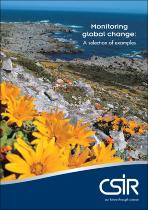JavaScript is disabled for your browser. Some features of this site may not work without it.
- ResearchSpace
- →
- Research Publications/Outputs
- →
- Books
- →
- View Item
| dc.contributor.author |
CSIR, Natural Resources and Environment

|
|
| dc.date.accessioned | 2011-12-01T09:08:44Z | |
| dc.date.available | 2011-12-01T09:08:44Z | |
| dc.date.issued | 2008-02 | |
| dc.identifier.citation | CSIR. 2008. Monitoring global change: a selection of examples, CSIR, South Africa | en_US |
| dc.identifier.uri | www.csir.co.za | |
| dc.identifier.uri | www.dst.gov.za | |
| dc.identifier.uri | www.nrf.ac.za | |
| dc.identifier.uri | www.africaclimatescience.org | |
| dc.identifier.uri | http://hdl.handle.net/10204/5356 | |
| dc.description | This booklet was made possible with the assistance of the Department of Science and Technology. For more information contact the Department of Science and Technology, the National Research Foundation and Africa Centre for Climate and Earth System Science. | en_US |
| dc.description.abstract | The reality of global change (including climate change) has gripped the imaginations of movie moguls, graced the agendas of international organisations such as the United Nations, and now also receives prominent attention from the international research community. Global change extends across environmental, cultural, political and demographical spheres. As more interaction between socio-economic and environmental factors occurs, the vulnerability of nations to human-induced environmental hazards also increases. Global climate change is, therefore, more and more perceived as a development problem as variations in the weather resulting in, for example, drought or flooding, have adverse consequences for sustained economic growth. Although forecasts of changes in weather patterns over the next few days have reached a high level of skill, predictions of climatic fluctuations over several months and of global climate changes over several decades are difficult due to the very complex interaction of various factors that determine weather and climate. Among other interventions, monitoring and observation programmes form an essential part in acquiring the data necessary for comprehensive situation analysis and ultimately, longterm predictable climatic behaviour. The following material gives a brief overview of some of the research activities conducted by the CSIR (and in partnership with other stakeholders) in the pursuit of understanding the processes and drivers associated with global climate change | en_US |
| dc.language.iso | en | en_US |
| dc.publisher | CSIR | en_US |
| dc.relation.ispartofseries | Workflow request;71111 | |
| dc.subject | Environment | en_US |
| dc.subject | Vegetation phenology | en_US |
| dc.subject | Remote sensing | en_US |
| dc.subject | Fire research | en_US |
| dc.subject | Algal bloom monitoring | en_US |
| dc.subject | Imaging spectroscopy | en_US |
| dc.subject | Hyper-structural lidar activities | en_US |
| dc.subject | Kruger National Park | en_US |
| dc.subject | Climate change | en_US |
| dc.title | Monitoring global change: a selection of examples | en_US |
| dc.type | Book | en_US |
| dc.identifier.apacitation | CSIR, N. R. a. E. (2008). <i>Monitoring global change: A selection of examples</i>. CSIR. http://hdl.handle.net/10204/5356 | en_ZA |
| dc.identifier.chicagocitation | CSIR, Natural Resources and Environment. <i>Monitoring global change: A selection of examples</i>. n.p.: CSIR. 2008. http://hdl.handle.net/10204/5356. | en_ZA |
| dc.identifier.vancouvercitation | CSIR NRaE. Monitoring global change: A selection of examples. [place unknown]: CSIR; 2008.http://hdl.handle.net/10204/5356 | en_ZA |
| dc.identifier.ris | TY - Book AU - CSIR, Natural Resources and Environment AB - The reality of global change (including climate change) has gripped the imaginations of movie moguls, graced the agendas of international organisations such as the United Nations, and now also receives prominent attention from the international research community. Global change extends across environmental, cultural, political and demographical spheres. As more interaction between socio-economic and environmental factors occurs, the vulnerability of nations to human-induced environmental hazards also increases. Global climate change is, therefore, more and more perceived as a development problem as variations in the weather resulting in, for example, drought or flooding, have adverse consequences for sustained economic growth. Although forecasts of changes in weather patterns over the next few days have reached a high level of skill, predictions of climatic fluctuations over several months and of global climate changes over several decades are difficult due to the very complex interaction of various factors that determine weather and climate. Among other interventions, monitoring and observation programmes form an essential part in acquiring the data necessary for comprehensive situation analysis and ultimately, longterm predictable climatic behaviour. The following material gives a brief overview of some of the research activities conducted by the CSIR (and in partnership with other stakeholders) in the pursuit of understanding the processes and drivers associated with global climate change DA - 2008-02 DB - ResearchSpace DP - CSIR KW - Environment KW - Vegetation phenology KW - Remote sensing KW - Fire research KW - Algal bloom monitoring KW - Imaging spectroscopy KW - Hyper-structural lidar activities KW - Kruger National Park KW - Climate change LK - https://researchspace.csir.co.za PY - 2008 T1 - Monitoring global change: a selection of examples TI - Monitoring global change: a selection of examples UR - http://hdl.handle.net/10204/5356 ER - | en_ZA |






